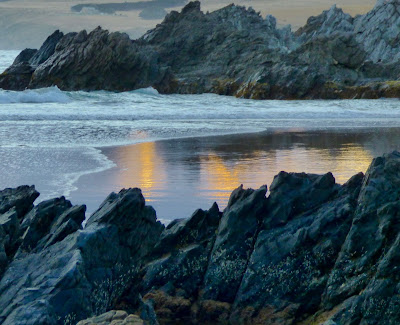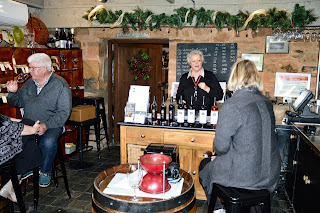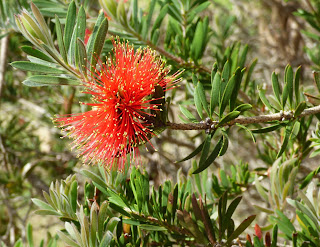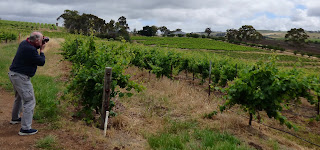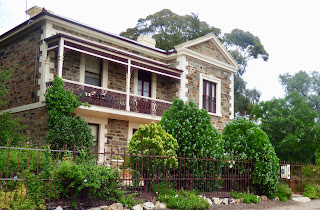How lovely it was to take a three-day break and visit the Clare Valley wine region. We haven't been away for months because of the virus. We postponed our May wedding anniversary booking to November, hoping precautions would have eased by then. And they were - restaurants were open, tastings were back on and the local community was very welcoming.
It was about a four-hour drive from home, with Clare about two hours north of Adelaide. First stop Auburn, a small town with a rich history and chock full of heritage buildings.

 |
| Post Office 1862 - and still a post office today! |
 |
St Johns Anglican Church 1862.
|
I'm a big fan of Institutes and look for them in every country town. Auburn's was built in 1866 with an 1884 addition (looking a bit tacked on, I reckon) to the left.
Pioneers grazed cattle and sheep in the early days of the district. Then in the 1850s copper was discovered at nearby Burra and Auburn was on the route transporting the copper to the port near Adelaide. Businesses were quickly established and the town boasted breweries, a flour mill, gasworks, an apothecary, a shoe factory and a foundry - all long gone. I tried to imagine the huge bullock drays lumbering through this now peaceful hamlet.
The main street boasted a ladies mounting stone, useful for ladies to gracefully alight onto their horses. A local stonemason made several of these and placed them around the town.
On the edge of town was the former railway station, now tastefully adapted for cellar door sales. A photo nearby showed a group of local ladies in their best finery waiting at the station to board the train in 1918 for a trip to the seaside. What excitement they must have felt anticipating the journey from their dry and hot environment to enjoy a day at the beach. How times have changed - the service operated twice daily from Adelaide to Clare until the railway was abandoned in 1983.
A little disappointing (for me) was the lack of information about the town's most famous person - author and poet C J Dennis, who is best known for the 1915 poem The Songs of the Sentimental Bloke. On a block of land now occupied by a nondescript building was a sign indicating that this was the former site of the Auburn Hotel operated by Dennis' father and the birthplace of C J (Clarence James). A brochure said a drinking fountain, birdbath and a model of the hotel now stand in memory of him - but we couldn't see them.
xxxxxxxxxxxxxxxxx
A little further north was the dot-on-the-map-town of Penwortham, named by pioneer settler John Horrocks after his hometown in England. The scene today is a bucolic one of grazing sheep and vines.
Horrocks was only 21 when he ventured north of Adelaide with his brother Eustace in 1839. The first white men in this area, they explored the region by camel, then established this tiny settlement. A letter written to his family says ' ... have commenced building a two-room cottage of stone'. Using only materials close to hand and the tools they had with them, the brothers managed to construct a solid and comfortable, if austere, home for themselves. The building is the oldest stone cottage in this area, and has been restored to as close to its original state as possible.
We peered in the windows but it was too difficult to see anything, so being exceedingly clever, I merely took a photo of the photos on the information sign outside the cottage.
In 1846 the brothers left to explore the far north of South Australia. Sadly, John was accidentally shot while loading his shotgun when a camel knocked into him. He died of his wounds, aged 28 years.
xxxxxxxxxxxxxxxxx
As if all this history wasn't enough, we drove on to Burra roughly 42kms north-east. Burra was the site of a busy copper mining industry in the 1850s to 70s. It is now a National Heritage-listed town and is replete with restored public buildings, shops, miners cottages, and remnants of its mining past.
In the centre of the town was an elaborate gazebo ...
... and the War Memorial that displayed a couple of Krupp field guns captured from the Germans. You can just see one peeking out behind the roses.
This is what it looked like when the guns were first placed there around 1920.
We were there just after Remembrance Day so there were a number of wreaths placed at its base.
Many of the buildings are made of the local stone - and they look fabulous. Here's one example.
I loved exploring this shop ....
... and discovering this old bike. Not sure who would buy it.
We drove a little way out of town to the mine site and wandered around, trying to imagine how it would have looked and sounded at the height of production. Here's a glimpse of what we saw.
 |
| The building on the left is the engine house and is believed to be the only fully-restored Cornish engine house outside of Cornwall. |
While all around us was mining heritage, I looked up and saw a swathe of succulents silhouetted against the sky, looking almost menacingly triffid-like.

The sketches always seemed to include dogs, children, horses, comical figures and slice-of-life events as well as records of various mining activities.
And in this watercolour he depicts the local Ngadjuri people.
An artist whose exhibition was opening at the art gallery in a couple of days wanted to try her special effects out on us. She had done a series of artwork based on an old hut that her parents had bought and transported to the Yorke Peninsula; the large hut had housed nurses during World War 2 and was one of many auctioned off after the war. By pointing an iPad at the artwork, photographs and other images of life at that time appeared on the screen. It was a very effective way of seeing 'inside' the painting.
Having been immersed in history for so long, we were ready for a cup of tea and a lie down! We headed north to our cottage which was our base for the next couple of nights. And here it is - the Pavilion, the honeymooners cottage in the town of Clare.
Next blog... we explore the wineries and restaurants of the Clare Valley.







